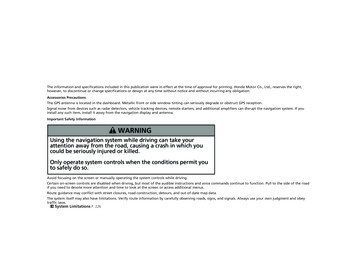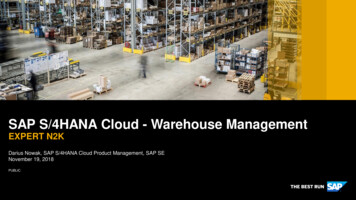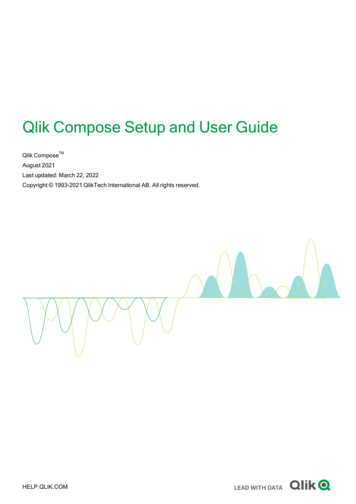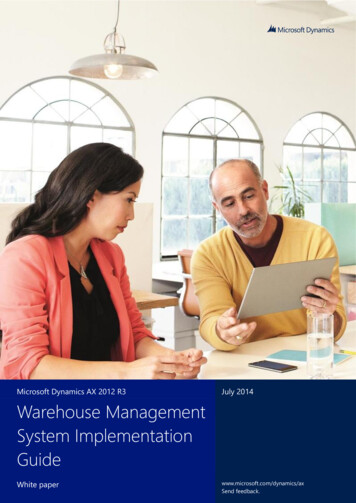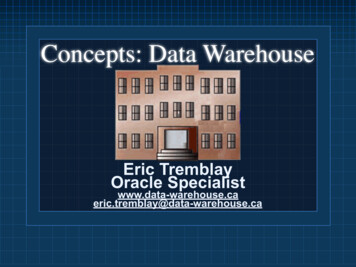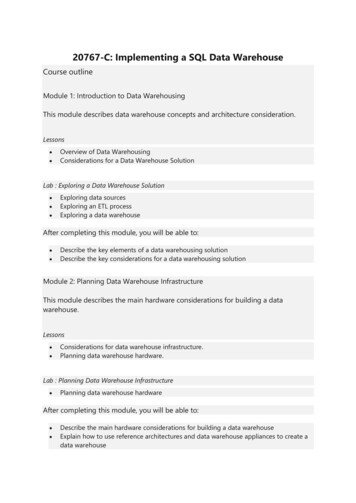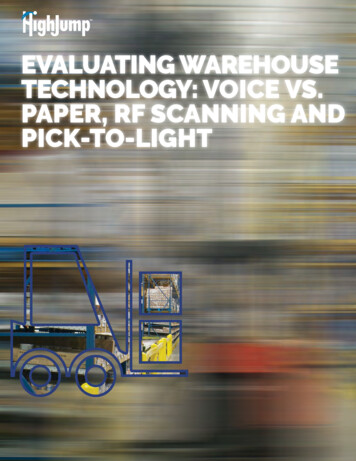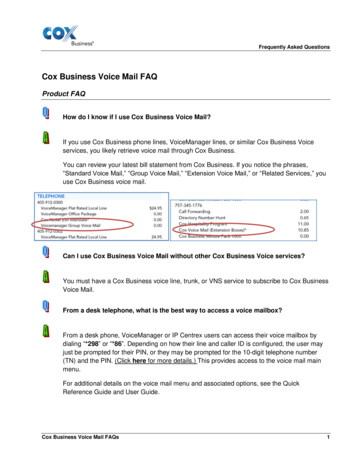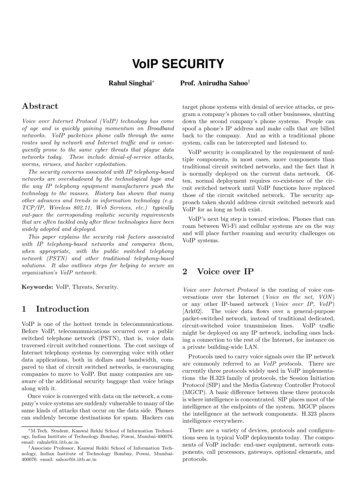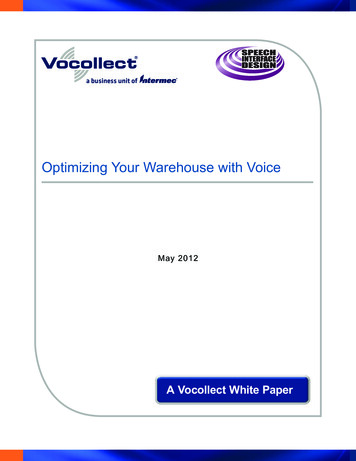
Transcription
Optimizing Your Warehouse with VoiceMay 2012A Vocollect White Paper
Optimizing Your Warehouse with VoiceA Vocollect White PaperTable of ContentsExecutive Overview . . . . . . . . . . . . . . . . . . . . . . . . . . . . . . . . . . . . . . . . . . . . . . . . . . . 1Key Business Challenges in the DC. . . . . . . . . . . . . . . . . . . . . . . . . . . . . . . . . . . . . . . . . .1Finding the Right Solution to Address Key Business Challenges . . . . . . . . . . . . . . . . . . . . . . . . . . . . 2Addressing Key Business Challenges with Voice-Enabled Workflows . . . . . . . . . . . . . . . . . . . . . . . . . .3Conclusion . . . . . . . . . . . . . . . . . . . . . . . . . . . . . . . . . . . . . . . . . . . . . . . . . . . . . . . .7 2012, Intermec IP Corp. All rights reserved. www.vocollect.com
Optimizing Your Warehouse with VoiceA Vocollect White PaperExecutive OverviewBusinesses today face many challenges and nowhere is it more prevalent than the supply chain,particularly in the distribution center (DC), where supply meets demand. Management is expectedto contain or reduce costs while supporting higher volumes of goods and improving customerservice levels. To meet these expectations, new technologies are often evaluated for their ability toadd efficiency and to provide a competitive advantage in the marketplace.While many organizations use a combination of technologies, industry leaders have determinedthat using a single technology, voice, can provide significant synergies across multiple workflows.This white paper explores how voice technology addresses key business challenges, compares itwith other available technologies, and, finally, provides an overview of the benefits a voice-enabledwarehouse/DC can provide.Key Business Challenges in the DCBusiness GrowthIn a survey commissioned by Vocollect over 200 logistics executives with distribution managementresponsibilities responded that “Supporting Business Growth” was one of the top reasons thatprompted them to investigate new technology-based solutions. Organizations today are looking toprocess higher volumes or a larger number of unique products with the same resources. A majorconcern for growing businesses is to avoid operational bottlenecks and depleted stock locationswhile reducing labor costs (particularly overtime). The goal of technology is to synchronize the flowof products and maximize efficiency throughout the DC.Improving Customer ServiceOrder accuracy is critical and is often a core performance metric in supporting customer servicelevel agreements. For example, a DC with an order accuracy level of 99.0% that ships 10 millionorders per year will produce 100,000 errors per year. Assuming the cost per error is 10 to 20,the bottom line impact of a 1% error rate will equate to 1 to 2M. Furthermore, this large numberof errors will generate customer complaints, refund requests, redundant shipping charges, and andultimately will inhibit profitable growth.As errors can be introduced at multiple points in the DC, reducing error rates typically requiresprocess changes across multiple workflows. 2012, Intermec IP Corp. All rights reserved. www.vocollect.com1
Optimizing Your Warehouse with VoiceA Vocollect White PaperReducing Operational CostsWorld-class businesses are finding ways to reduce operational costs as they support top-line growthand improve customer service by redesigning processes and deploying cost effective technology.In many DCs, the most labor-intensive tasks have already been addressed with process changeand technology - so how do managers find new sources of operational cost reduction withoutsacrificing customer service levels?Finding the Right Solution to Address Key BusinessChallengesThe leading technologies used in the DC today include voice, RF bar code scanning and pick-to-light.Each technology has inherent benefits that vary based on the unique aspects of the deploymentenvironment and use case. Additionally, each technology provides a significant improvement overpaper.PaperAccuracyPick Rates (cases)VoiceRF Scanning97% - 99%99.8% - 99.98%99.3% - 99.5%to 220 lines/dayto 300 lines/hourto 200 lines/hourPick-to-Light99.5% - 99.7%to 350 lines/hourTraining Time2-5 days1-2 days2-4 days1-2 daysDeployment AgilityFlexibleFlexibleFlexibleNot FlexibleApplicable Uses: PickingYesYesYesYes ReplenishmentYesYesYesNo ReceivingYesYesYesNo Inventory CountYesYesYesNo Mixed /Eyes RequiredHands/Eyes FreeHands/Eyes RequiredNoVery HighHands/Eyes RequiredFigure 1. Comparison of leading warehouse technologies. Estimates are based on reported savings. Source: Vocollect.As the chart above shows, voice stands out by providing a flexible solution with high accuracy andreasonable implementation costs. While RF scanning is less expensive, it is also less efficient.Pick-to-light can prove effective in select picking locations, providing the products and locations donot change. Because voice can be deployed throughout the warehouse, organizations can obtainsynergistic benefits of reduced training, integration, and maintenance only achieved by using asingle technology. 2012, Intermec IP Corp. All rights reserved. www.vocollect.com2
Optimizing Your Warehouse with VoiceA Vocollect White PaperOther benefits of using voice-directed work in the DC include: Hands and eyes are free. In picking, workers do not have to continuously set down a scanneror paper and can easily pick up multiple units at a time. For fork-based operations it means amuch safer and more efficient environment - operators no longer need to look at screens fordirections, eliminating accident causing distractions. Significant savings can be created by changing processes, resulting in savings from pickingmultiple orders simultaneously, interleaving workflows such as cycle counting with picking and/or put-away, or reverse picking to reduce travel time. Training time is significantly reduced with voice. Because the worker is told what to dostep-by-step, the average worker can be trained and completing tasks at a high level in one totwo hours. Workers are directed and paced, to keep them moving and reduce extraneous time loss. Individual workers can be monitored for performance. It is ideal when engineered standardsare deployed.Addressing Key Business Challenges with Voice-EnabledWorkflowsDefinition and BenefitsThe most natural interface for most workers is one that allows hands and eyes to be free to performthe tasks to which the worker is assigned. A voice-enabled DC is one that delivers the benefitsof ‘Hands-Free, Eyes-Free ’ work in most, if not all workflows and is an integral driver for reengineering processes and systems. DCs that realize the greatest benefits generally are thosethat have a high velocity of transactions with a high degree of variability. Some DCs may also seesignificant gains from voice-centric DC design when workflows have relatively low overlap; that is,receiving, put-away, picking, replenishment and loading are performed at different times throughoutthe day.The DC realizes the largest gains when voice is central to the initial design and a driver for processre-engineering. DC processes can be synchronized with one another to reduce bottlenecks. Forexample, two workflows that use the same type of vehicle (e.g. put-away and replenishment) maybe interleaved to make optimal use of the capital equipment and increase the productivity of thedrivers. Training is reduced and workers can more readily be moved between assignments asneeded, since there is only one system to be learned. 2012, Intermec IP Corp. All rights reserved. www.vocollect.com3
Optimizing Your Warehouse with VoiceA Vocollect White PaperIn a voice-enabled DC, processes are standardized and the human-computer interface is optimized.In particular, highly directed workflows require a high degree of input and output between the workerand the computer. In these workflows, the computer is issuing a constant stream of directions,and the worker acknowledges receipt and completion. Using voice in these applications deliversdramatic gains in speed and convenience when compared to the use of screens, keypads andhandheld scanning devices.A Brief Overview of a Voice-Enabled WorkflowA voice-enabled workflow is one where the DC worker is directed by hearing locations, quantities,and other information from the warehouse management system (WMS) and confirming actions withvoice commands. Information from the WMS is transformed to speech, guiding the worker througheach line of an order, providing item location and quantity required. The worker verbally confirmsthe location via a number, or check digit, located where the product is stored, and then confirmsthe quantity picked. The voice system and worker continue through the order list until the orderis complete. Verbal confirmation of actions taken, while not taking one’s eyes off of the activityperformed, increases accuracy. Using one’s hands exclusively to pick items (versus manipulatinga handheld device) makes a worker significantly more productive. In the end, voice-directed workis the most productive and accurate method of work for people who operate in high velocity DCs.Implementing VoiceA voice-enabled workflow solution is composed of many elements - most importantly, processexpertise. Process expertise is important because implementing voice in a DC with poor processeswill not generate the desired productivity and accuracy improvements. Voice-specific processexpertise - combined with industry-specific expertise - is needed to ensure the maximum benefitsfrom a voice deployment.Vocollect Data Process eConsoleManagementWMS/ERP/LegacyVoice Applicationfor WorkflowTask“Aisle 25”“414”“Ready”“2-8-7”“Pick 2”Enterprise Connector Options:Examples of Voice-Enabled Workflows: Vocollect VoiceExpress cle-CountingAuditing Vocollect VoiceLink Vocollect VoiceInterface Objects Vocollect VoiceDirect Vocollect VoiceDirect ERP for SAP 2012, Intermec IP Corp. All rights reserved. www.vocollect.com“2”“417”Voice-Enabled Worker4
Optimizing Your Warehouse with VoiceA Vocollect White PaperWMS InterfaceA voice-enabled workflow solution starts by interfacing to the WMS. The voice system, whichincludes both the software that defines a voice-enabled workflow and the hardware, or voiceappliance, used by workers to interact with the WMS, must link with the WMS in order to receivework instructions, provide acknowledgements of tasks completed, and update inventory levels. Tominimize costly customization, the system should allow for multiple interface options, as WMSproviders vary in their approach. With some WMSs, the WMS provider will implement a directinterface that integrates the new voice process logic directly into the WMS and enables a realtime interface between the voice system and the WMS. With others, a middleware application canprovide the ability to communicate to and from the WMS without making WMS code changes.Voice ApplicationsA voice application is created for each workflow and specifies precisely the interaction betweenthe WMS and the worker. Typically a separate voice application is developed for each workflow inthe DC (e.g., picking, put-away, replenishment). If workflows are interleaved, a voice applicationwill be developed for the combined workflow. These applications are developed using vendorsupplied tools and, once complete, are loaded onto the voice appliance. The system must allowvoice-enabled workflows to be developed quickly to adapt to any changes in DC operations.Voice Appliance and HeadsetFor workers, the essential components of the voice solution include a purpose-built voice appliance,an industrial headset and the associated voice software. This combination converts directionsfrom the WMS (e.g. which items to pick) into speech which the user receives through the headset.It also recognizes the user’s speech and captures this input into the system. The voice appliancemay be worn on a user’s belt (battery-powered) or may be mounted on a vehicle (vehicle-powered).The appliance runs firmware which processes the voice applications, communicates with remotesystems, converts text instructions to speech, and recognizes the user’s speech.Management of the Voice SystemTo better manage voice appliances, a “dashboard” monitoring and management system isdeployed within the DC. Such a management system enables device management, downloadingof new voice applications to the appliances, viewing of performance statistics, tracking of devicelocations, battery performance monitoring, and other functions. 2012, Intermec IP Corp. All rights reserved. www.vocollect.com5
Optimizing Your Warehouse with VoiceA Vocollect White PaperIntegrated voice-directed systems are optimized to provide the ideal solution, enablingorganizations to achieve key business objectives with the lowest overall total cost of ownership.In addition, the ergonomics of a purpose-built integrated solution improve worker satisfaction reducing absenteeism, turnover and costly errors.Integrated Voice Solutions: Purpose-Built for the Distribution CenterThe DC environment demands an ’end to end’ solution designed specifically for the challengingDC environment. While various suppliers may offer components of the solution, when a solutionis assembled using multiple suppliers, the customer or value-added reseller takes on the onus ofcreating an inter-operable solution.By deploying an integrated, end to end solution such as Vocollect Voice , the organization willrealize greater return since it has been tuned and optimized for their environment. A true endto-end solution starts with the headset - with a microphone that is designed to “hear” the user’svoice and filter out ambient noises. The microphone must be able to withstand the rigors of thework environment, including extreme temperatures and/or condensation that is present in manyfacilities. To ensure worker safety, a purpose-built headset cable and connector are designed tosafely disengage (without damage) from the voice appliance if the cable is “snagged”. Alternativesolutions require expensive adapter cables and typically provide non-rugged connections that areoften sources of speech recognition errors, impacting speed. Wireless options that have beentuned for high quality transmission of voice (in order for speech recognition to operate properly)are also available for applications which require cable-free use.A voice appliance like the Vocollect Talkman , which is a purpose-built mobile computer for DCapplications, is able to withstand extreme temperatures and handle the drops and bumps thataccompany DC work. These appliances are ergonomically designed, with minimal need forkeypad usage. Purpose-built appliances also eliminate the need for an integrated display whichis often a source of error, inefficiency, and breakdowns. The battery in these appliances typicallyaccommodates a full shift, plus overtime (8 to 12 hours). It also accommodates a wide variety oflanguages, dialects and accents (including its OS, memory, audio circuitry, and speech recognitionsoftware).Vehicle-based workers can also benefit from voice-directed work using the same voice appliancein a vehicle mount configuration. 2012, Intermec IP Corp. All rights reserved. www.vocollect.com6
Optimizing Your Warehouse with VoiceA Vocollect White PaperIn addition to the voice appliance, some applications may be optimized by using additionaltechnologies that complement voice. For example, in receiving, an adjunct screen can be usefulfor applications requiring an operator to browse through large amounts of information which wouldbe less efficient if delivered using voice. Also, long pallet identification numbers must be recorded,or where one is inducting totes, a barcode scanner may be used in conjunction with the voicebased system.While it is possible to deploy a system that is a combination of individual disparate components,this approach often results in sub-optimized processes, higher maintenance costs, and difficulty indiagnosing root causes of system problems. Thus, an end-to-end solution design must include allof the necessary components outlined above to reduce ongoing costs and problems.ConclusionA voice-enabled DC provides a strategic platform which enables companies to grow while controllingoperating costs and improving customer service levels. Voice-directed workflows enable handsfree, eyes-free work and provide the most natural and effective method for workers to completetheir jobs. Voice-enabled DCs that implement an end-to-end solution realize the highest gainswith the lowest overall cost of ownership due to process improvements and synergies gainedfrom training and equipment use that can only be obtained by using the same technology acrossworkflows. 2012, Intermec IP Corp. All rights reserved. www.vocollect.com7
Improved Accuracy.Increased Productivity.Real Business Results.In the complex supply chain industry, accuracy andproductivity are of paramount importance. The proventrack record of voice in driving quantifiable performanceimprovements has made it a natural fit for processreengineering efforts to solve key business challenges.Vocollect, a business unit of Intermec, is the numberone provider of end-to-end voice solutions for mobileworkers worldwide, helping customers achieve a higherlevel of business performance. Together with ourpartners, we enable nearly 500,000 workers at almost2,000 companies around the globe to distribute US 4.5billion in goods every day. Contact Vocollect today tolearn how we can help you transform your operationaland workforce performance.www.vocollect.comSpeech Interface Design (SID) provides business process optimization solutions for distribution and manufacturingcustomers. Specializing in Vocollect Voice-based technology; SID offers Operational Site Assessments, Voice SystemSolutions development and Professional Services. To strategically cut operational costs, achieve business initiatives andincrease margin; consider re-engineered process flows that are voice directed.Speech Interface Design700 River Avenue, Suite 431Pittsburgh, PA 15212412.323.1135www.speech-interface.com Copyright 2012, Intermec IP Corp. All rights reserved. Vocollect, Vocollect Voice, VoiceApplications, VoiceArtisan, VoiceCatalyst, VoiceConsole,VoiceDirect, VoiceExpress, VoiceLink, VoiceInterface Objects, SoundSense, Talkman, Hands-Free, Eyes-Free, Vocollect Adapted Speech Recognitionand Voice-Directed Work are either registered trademarks or trademarks of Vocollect.Bluetooth is a registered trademark of SIG, Inc. All rights reserved.All other trademarks are property of their respective owners.
Optimizing Your Warehouse with Voice A Vocollect White Paper Other benefits of using voice-directed work in the DC include: Hands and eyes are free. In picking, workers do not have to continuously set down a scanner or paper and can easily pick up multiple units at a time. For fork-based operations it means a

